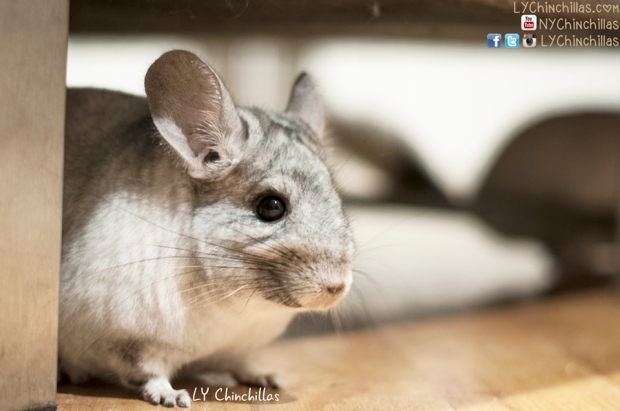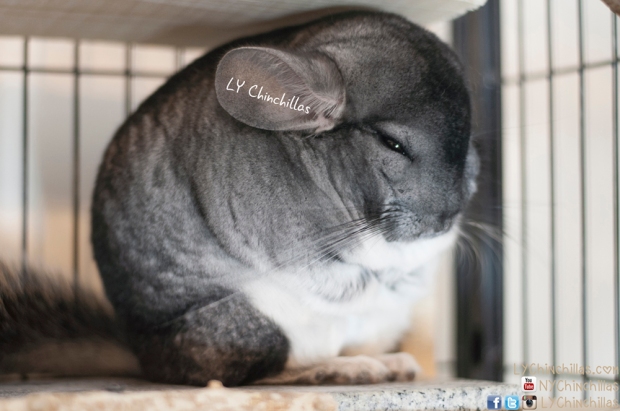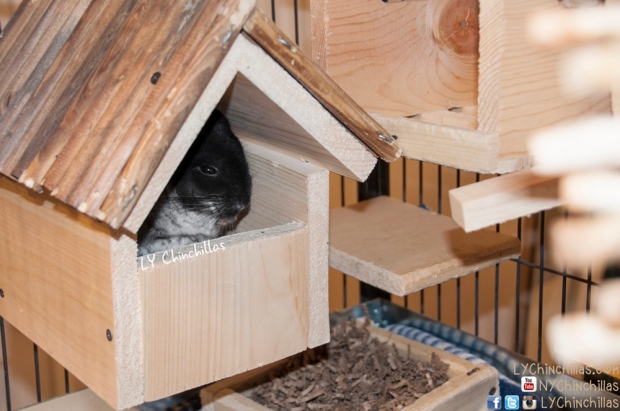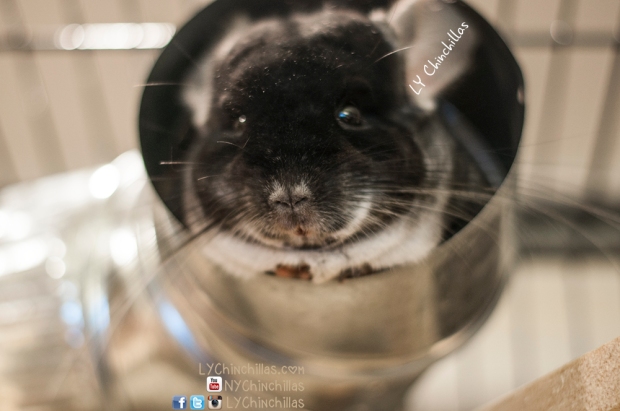This question comes up all the time from chinchilla owners, as it rightfully and naturally would. Should I get another chinchilla for my existing chinchilla(s)? Is my chinchilla lonely? Does my chinchilla deserve a playmate? Cage mate? Best friend?
The answer, unequivocally, is no. Well, it’s no and yes. Let me explain! If you are a current chinchilla owner, you know that chinchillas are unique animals that are a true gift to the world! They have one-of-a-kind personalities with their own cute idiosyncrasies, adorable quirks, and delightful oddities that are distinct to each individual pet. This allows us to come to a few conclusions: 1. Chinchillas are particular, 2. Chinchillas are individualistic, and 3. Chinchilla behavior can sometimes be categorized as inexplicable. These reasonable conclusions – along with the fact that chins can be territorial – show us that the odds of one chinchilla getting along with another chinchilla is slim (depending on your chinchilla’s personality, of course).
If you are a current chinchilla owner, you know that chinchillas are unique animals that are a true gift to the world! They have one-of-a-kind personalities with their own cute idiosyncrasies, adorable quirks, and delightful oddities that are distinct to each individual pet. This allows us to come to a few conclusions: 1. Chinchillas are particular, 2. Chinchillas are individualistic, and 3. Chinchilla behavior can sometimes be categorized as inexplicable. These reasonable conclusions – along with the fact that chins can be territorial – show us that the odds of one chinchilla getting along with another chinchilla is slim (depending on your chinchilla’s personality, of course). This is not to say that chinchillas can’t be properly introduced over time and come to be great mates – it’s only to say that your chinchilla does not need another chinchilla to live a long, happy life. This is a main point to consider. In my personal experience, every single one of my chinchillas (with the exception of the mosaic sisters Lulu and Fifi) live alone in their own cage and are living a healthy, satisfying existence. Do I wish they got along? Of COURSE! Did I try to bond them within reason? Definitely! Do I still have dreams? Forever and always. It’s my dream for all my babies to cuddle up and coo at me. However, it’s only a dream – that’s my reality, and that’s okay.
This is not to say that chinchillas can’t be properly introduced over time and come to be great mates – it’s only to say that your chinchilla does not need another chinchilla to live a long, happy life. This is a main point to consider. In my personal experience, every single one of my chinchillas (with the exception of the mosaic sisters Lulu and Fifi) live alone in their own cage and are living a healthy, satisfying existence. Do I wish they got along? Of COURSE! Did I try to bond them within reason? Definitely! Do I still have dreams? Forever and always. It’s my dream for all my babies to cuddle up and coo at me. However, it’s only a dream – that’s my reality, and that’s okay. The only reason you should get another chinchilla is because YOU – as a responsible, capable owner – want to take on the duty of another precious life in your home. That means double the mess, double the work, double the expense, double the personality, and double the adorable joy that comes from each and every chinchilla. Be aware that your decision will impact YOUR life, your existing chinchilla’s life, and your new chinchilla’s life as well. The main focus should be the well-being of your pets, despite their ability to cohabitate.
The only reason you should get another chinchilla is because YOU – as a responsible, capable owner – want to take on the duty of another precious life in your home. That means double the mess, double the work, double the expense, double the personality, and double the adorable joy that comes from each and every chinchilla. Be aware that your decision will impact YOUR life, your existing chinchilla’s life, and your new chinchilla’s life as well. The main focus should be the well-being of your pets, despite their ability to cohabitate. So, let’s say you’re ready to take the next step: another fluffy baby in the household! Great: congratulations for coming to this decision based solely on your willfulness to take on another chinchilla, understanding the great probability that he or she may not be able to live amicably with your current chinchilla. Bravo! What’s next? Firstly, if you have intentions to house your chinchillas together, you must purchase a chinchilla of the same sex (unless one of them has been fixed). Then, be sure to purchase all the necessities your FIRST chinchilla required: new cage, water bottles, shelves, hammocks, accessories, food bowls, and fleece! Do not pick up another chinchilla without first getting all the essentials that he or she may need. Never assume you can just plop him or her in with your existing fluffball – that could have devastating consequences for either or both babies. It’s also good to brush up on the basics for each new chinchilla, as no two are alike.
So, let’s say you’re ready to take the next step: another fluffy baby in the household! Great: congratulations for coming to this decision based solely on your willfulness to take on another chinchilla, understanding the great probability that he or she may not be able to live amicably with your current chinchilla. Bravo! What’s next? Firstly, if you have intentions to house your chinchillas together, you must purchase a chinchilla of the same sex (unless one of them has been fixed). Then, be sure to purchase all the necessities your FIRST chinchilla required: new cage, water bottles, shelves, hammocks, accessories, food bowls, and fleece! Do not pick up another chinchilla without first getting all the essentials that he or she may need. Never assume you can just plop him or her in with your existing fluffball – that could have devastating consequences for either or both babies. It’s also good to brush up on the basics for each new chinchilla, as no two are alike. Then, you can introduce your chinchillas slowly to one another, placing their cages near one another to allow them to get accustomed to new smells and the new presence. I won’t go into the controversial topic of talking about how exactly to introduce your chinchillas, as there are plenty of suggestions out there and very strongly opinionated owners. The safest way that I have found is to place them in proximity to one another with a barrier and allow them to react to one another without having to fear for their safety. Based on their reactions initially and over time, you can safely determine how they might react with one another. In my experience, my boys got along until the ladies arrived, and the ladies never got along with one another (aside from the sisters, of course). I would never consider housing the males and females together because none of them are fixed, and I don’t have the capability to take care of any kits with my very full-time job if anything were to go wrong with the birth. I can’t stomach the idea of losing any of my existing babies, even to their babies.
Then, you can introduce your chinchillas slowly to one another, placing their cages near one another to allow them to get accustomed to new smells and the new presence. I won’t go into the controversial topic of talking about how exactly to introduce your chinchillas, as there are plenty of suggestions out there and very strongly opinionated owners. The safest way that I have found is to place them in proximity to one another with a barrier and allow them to react to one another without having to fear for their safety. Based on their reactions initially and over time, you can safely determine how they might react with one another. In my experience, my boys got along until the ladies arrived, and the ladies never got along with one another (aside from the sisters, of course). I would never consider housing the males and females together because none of them are fixed, and I don’t have the capability to take care of any kits with my very full-time job if anything were to go wrong with the birth. I can’t stomach the idea of losing any of my existing babies, even to their babies.
What I’ve learned is that my chinchillas are generally solitary animals, and I am their best human friend. I clean, scratch, and provide emotional support to them (oft via song), and they have shown me time and time again that they don’t need – and never needed – another chinchilla friend for them to live a loved, loving life. No, your chinchilla is not lonely or lacking. Are they bored sometimes? Maybe. But that’s what stimulating cages, safe chews, and occasional treats or playtimes are for! You can provide a beautiful, fulfilling life for your chinchilla – never doubt that. They do deserve a great mate, and I’m certain they can find that in you.

LY Chinchillas Treat Donation
Donate healthy, delicious treats to LY Chinchillas to help keep our content going!
$5.00




 New DIY Goodies: I am a huge fan of DIY when it comes to the world of chinchillas:
New DIY Goodies: I am a huge fan of DIY when it comes to the world of chinchillas:  New Fleece: When the seasons change, so doth the fleece. While colors and designs bring a fresh new feel to their cages, it’s also important to discard fleece after a certain level of usage. Typically, when non-pill fleece starts to lose its original texture, that’s the sign to swap. Luckily, fleece ordered online is inexpensive and plentiful, meaning there’s tons of delightful – and affordable – designs to choose from!
New Fleece: When the seasons change, so doth the fleece. While colors and designs bring a fresh new feel to their cages, it’s also important to discard fleece after a certain level of usage. Typically, when non-pill fleece starts to lose its original texture, that’s the sign to swap. Luckily, fleece ordered online is inexpensive and plentiful, meaning there’s tons of delightful – and affordable – designs to choose from!


 New Accessories: Not only have we re-stocked on some fun hammocks for Muff and Koko, but we’ve also been fortunate enough to have discovered a new chinchilla vendor –
New Accessories: Not only have we re-stocked on some fun hammocks for Muff and Koko, but we’ve also been fortunate enough to have discovered a new chinchilla vendor –  While we’ve only managed to grab a few pumpkin and autumn-themed captures, we are keen on remaking
While we’ve only managed to grab a few pumpkin and autumn-themed captures, we are keen on remaking 













































